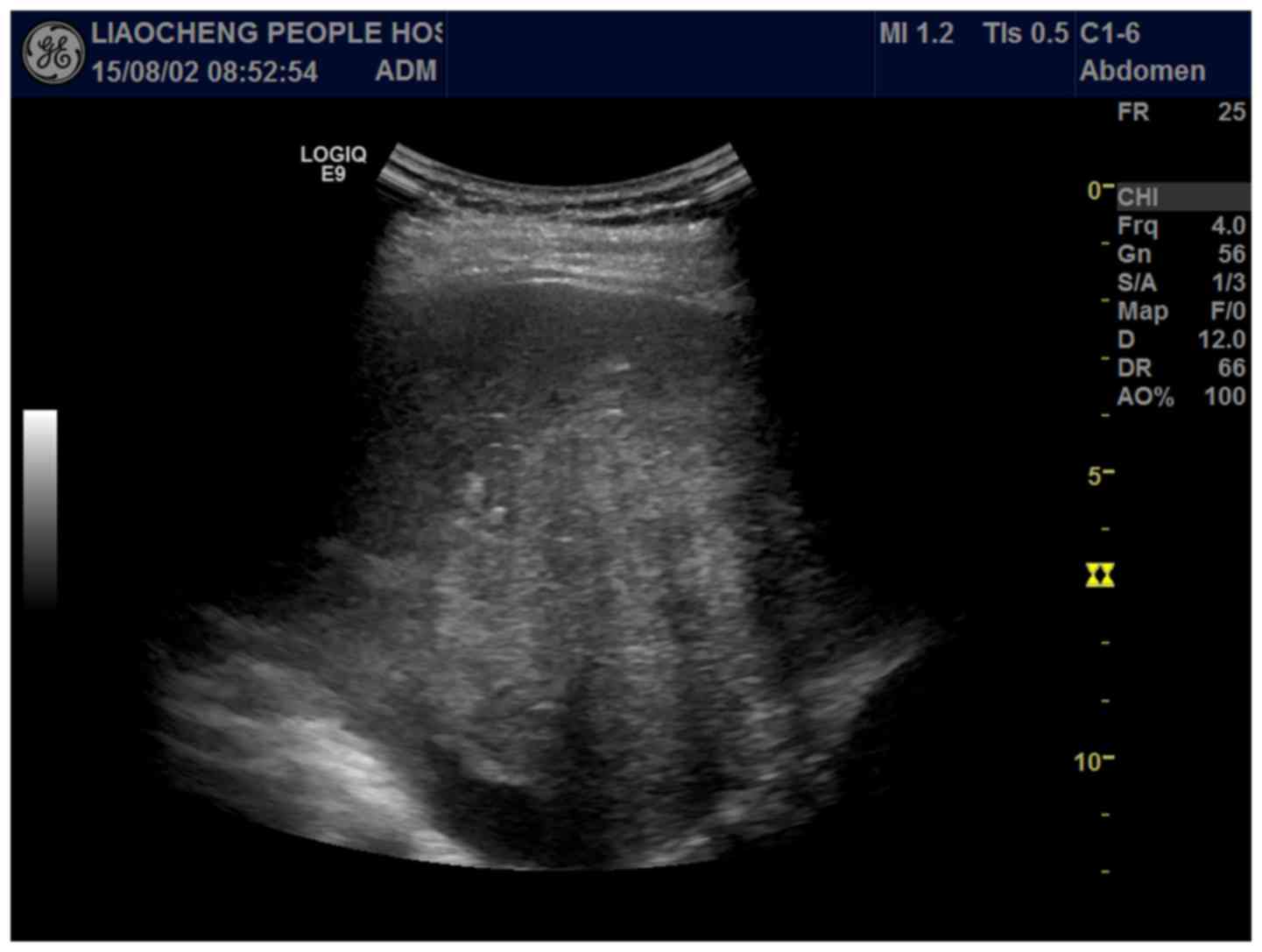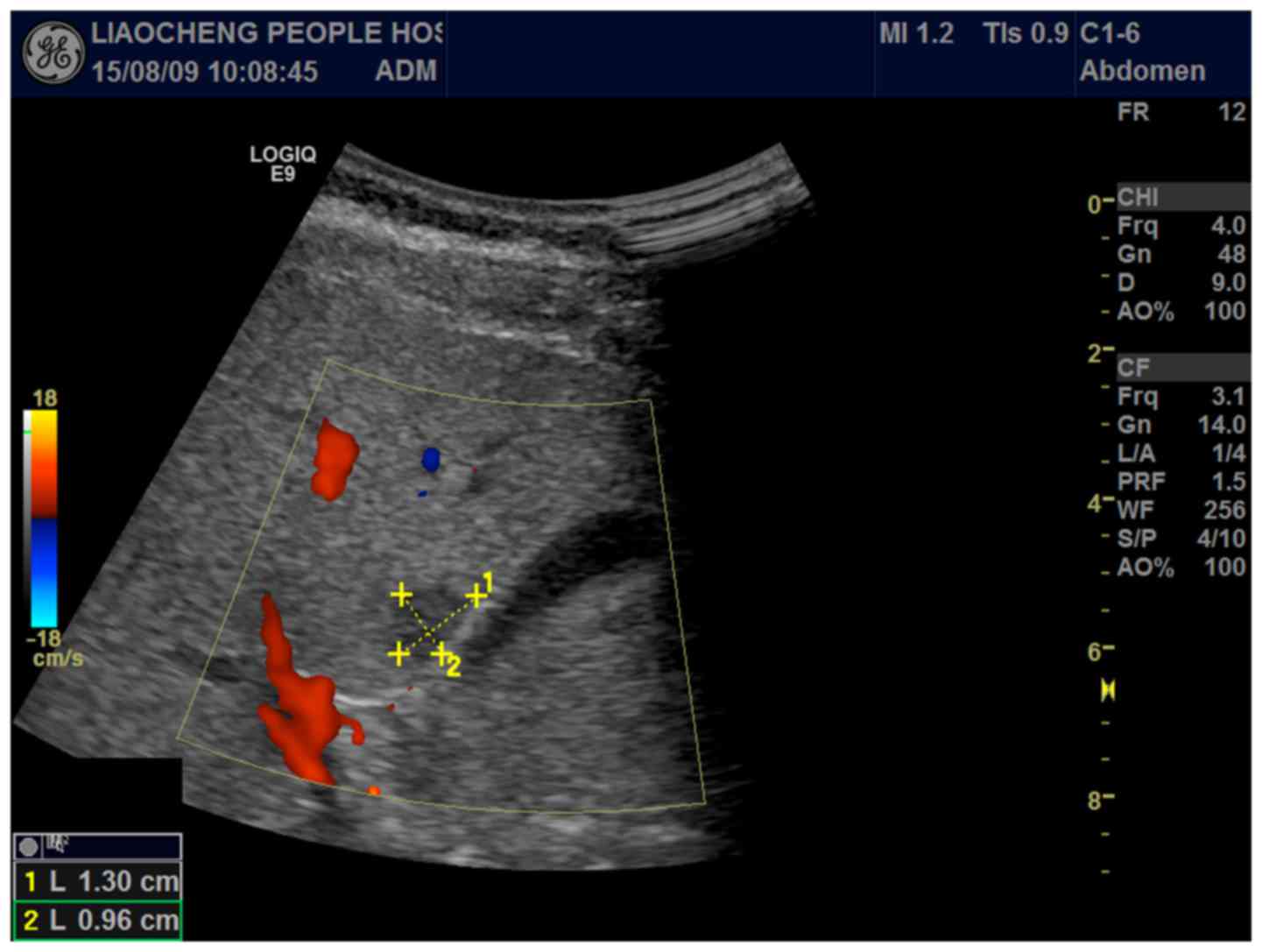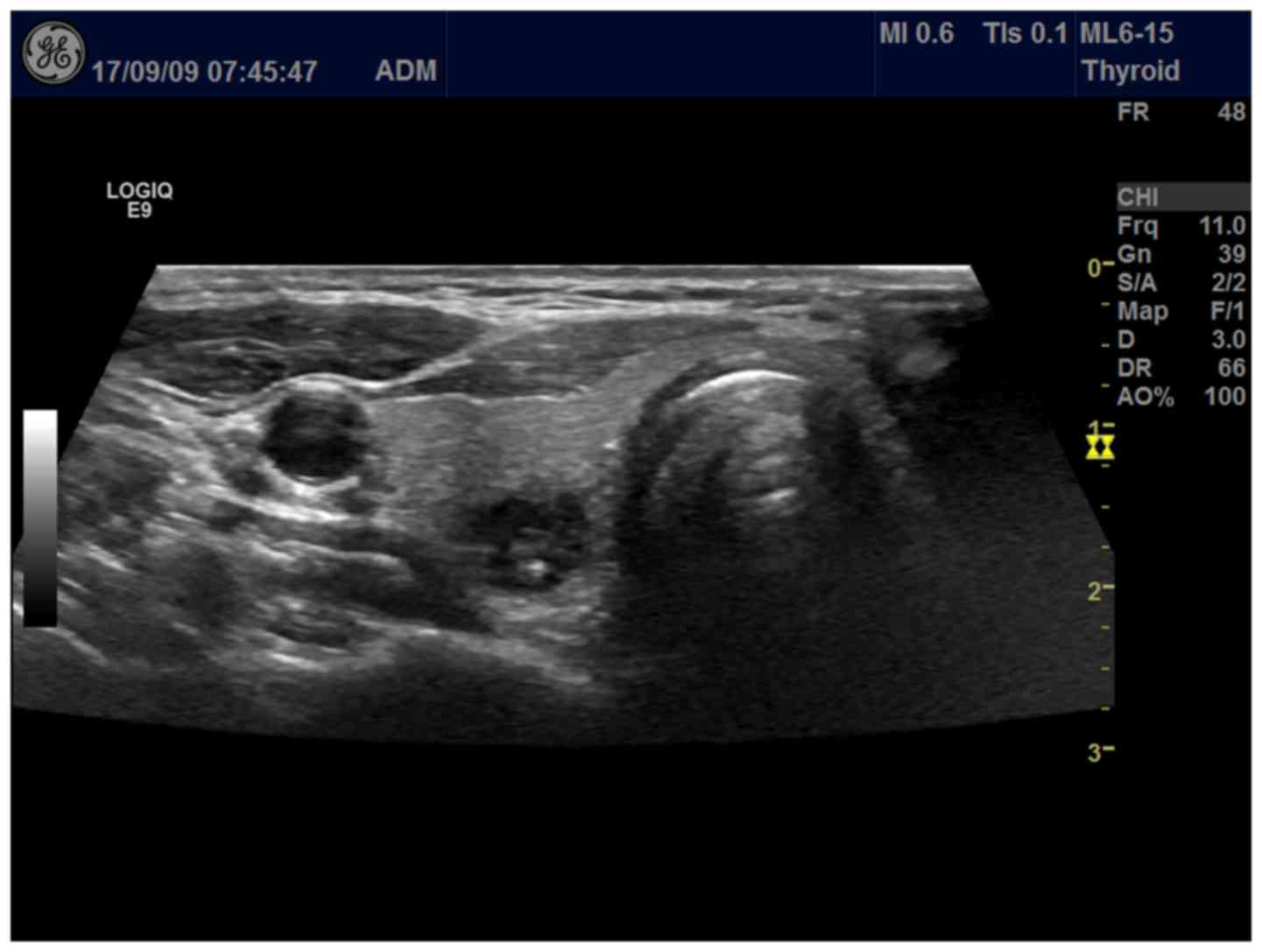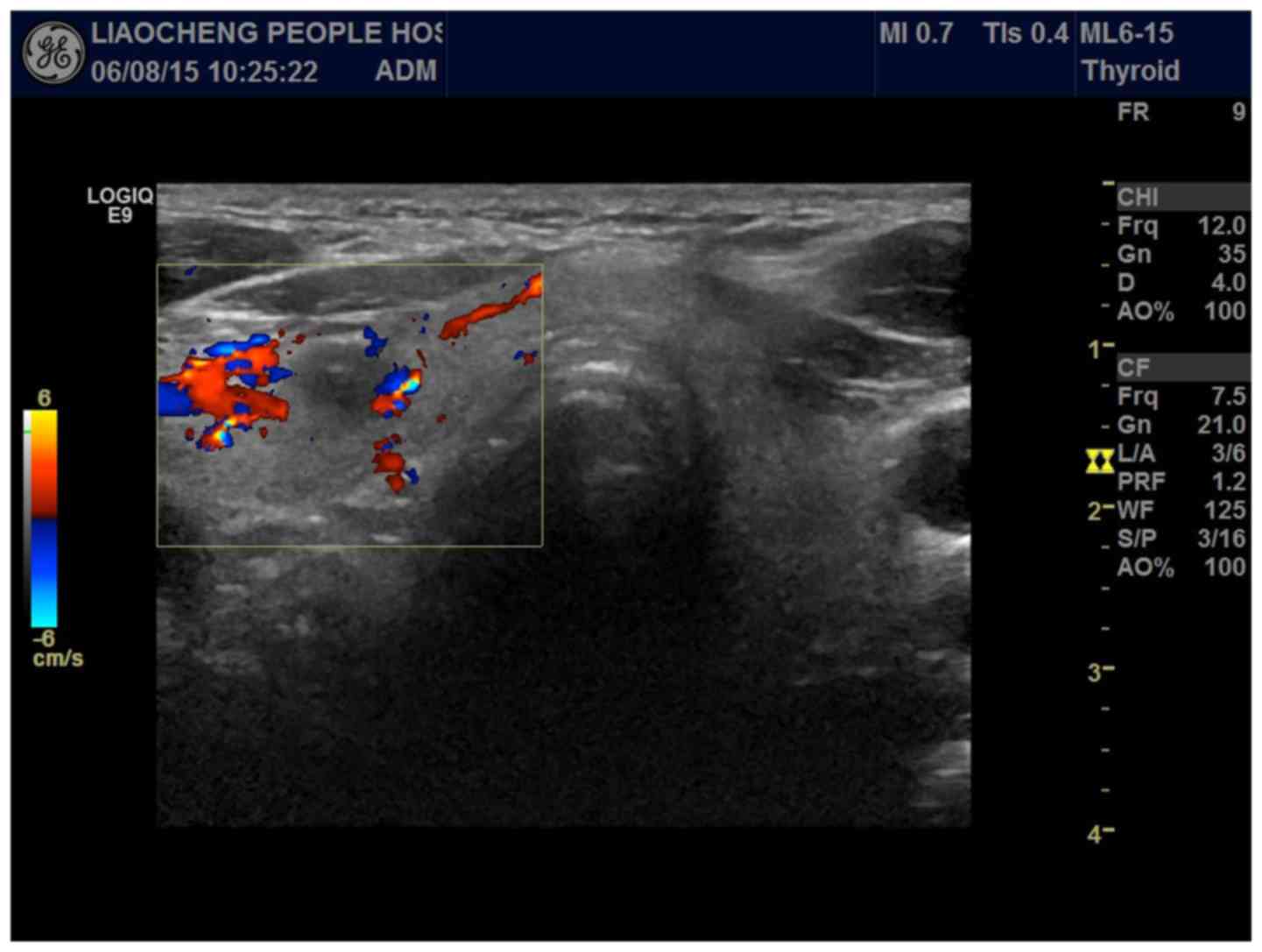|
1
|
Bhaijee F, Krige JE, Locketz ML and Kew
MC: Liver resection for non-cirrhotic hepatocellular carcinoma in
South African patients. S Afr J Surg. 49:68–74. 2011.PubMed/NCBI
|
|
2
|
Schlumberger M, Elisei R, Müller S,
Schöffski P, Brose M, Shah M, Licitra L, Krajewska J, Kreissl MC,
Niederle B, et al: Overall survival analysis of EXAM, a phase III
trial of cabozantinib in patients with radiographically progressive
medullary thyroid carcinoma. Ann Oncol. 28:2813–2819. 2017.
View Article : Google Scholar : PubMed/NCBI
|
|
3
|
Khalaf N, Ying J, Mittal S, Temple S,
Kanwal F, Davila J and El-Serag HB: Natural history of untreated
hepatocellular carcinoma in a US cohort and the role of cancer
surveillance. Clin Gastroenterol Hepatol. 15:273–281.e1. 2017.
View Article : Google Scholar : PubMed/NCBI
|
|
4
|
Liu J, Marcaccio MJ, Young JE, Aziz T, Wat
J and Asa SL: Pancreatic struma with papillary thyroid carcinoma: A
diagnostic dilemma. Endocr Pathol. 28:91–94. 2017. View Article : Google Scholar : PubMed/NCBI
|
|
5
|
Sia D, Villanueva A, Friedman SL and
Llovet JM: Liver cancer cell of origin, molecular class, and
effects on patient prognosis. Gastroenterology. 152:745–761. 2017.
View Article : Google Scholar : PubMed/NCBI
|
|
6
|
Elisei R, Schlumberger MJ, Müller SP,
Schöffski P, Brose MS, Shah MH, Licitra L, Jarzab B, Medvedev V,
Kreissl MC, et al: Cabozantinib in progressive medullary thyroid
cancer. J Clin Oncol. 31:3639–3646. 2013. View Article : Google Scholar : PubMed/NCBI
|
|
7
|
Zhou J, Luo Y, Ma BY, Ling WW and Zhu XL:
Contrast-enhanced ultrasound diagnosis of hepatic metastasis of
concurrent medullary-papillary thyroid carcinoma: A case report.
Medicine (Baltimore). 96:e90652017. View Article : Google Scholar : PubMed/NCBI
|
|
8
|
Li F, Han J, Han F, Wang JW, Luo RZ, Li AH
and Zhou JH: Combined hepatocellular cholangiocarcinoma
(biphenotypic) tumors: Potential role of contrast-enhanced
ultrasound in diagnosis. AJR Am J Roentgenol. 209:767–774. 2017.
View Article : Google Scholar : PubMed/NCBI
|
|
9
|
Hong YR, Luo ZY, Mo GQ, Wang P, Ye Q and
Huang PT: Role of contrast-enhanced ultrasound in the pre-operative
diagnosis of cervical lymph node metastasis in patients with
papillary thyroid carcinoma. Ultrasound Med Biol. 43:2567–2575.
2017. View Article : Google Scholar : PubMed/NCBI
|
|
10
|
Xu B, Scognamiglio T, Cohen PR, Prasad ML,
Hasanovic A, Tuttle RM, Katabi N and Ghossein RA: Metastatic
thyroid carcinoma without identifiable primary tumor within the
thyroid gland: A retrospective study of a rare phenomenon. Hum
Pathol. 65:133–139. 2017. View Article : Google Scholar : PubMed/NCBI
|
|
11
|
Kitahata S, Hiraoka A, Kudo M, Murakami T,
Ochi M, Izumoto H, Ueki H, Kaneto M, Aibiki T, Okudaira T, et al:
Abdominal ultrasound findings of tumor-forming hepatic malignant
lymphoma. Dig Dis. 35:498–505. 2017. View Article : Google Scholar : PubMed/NCBI
|
|
12
|
Gannon AW, Langer JE, Bellah R, Ratcliffe
S, Pizza J, Mostoufi-Moab S, Cappola AR and Bauer AJ: Diagnostic
accuracy of ultrasound with color flow Doppler in children with
thyroid nodules. J Clin Endocrinol Metab. Mar 12–2018.(Epub ahead
of print). View Article : Google Scholar : PubMed/NCBI
|
|
13
|
Ling W, Qiu T, Ma L, Lei C and Luo Y:
Contrast-enhanced ultrasound in diagnosis of primary hepatic
angiosarcoma. J Med Ultrason (2001). 44:267–270. 2017. View Article : Google Scholar : PubMed/NCBI
|
|
14
|
Shin JH, Baek JH, Chung J, Ha EJ, Kim JH,
Lee YH, Lim HK, Moon WJ, Na DG, Park JS, et al Korean Society of
Thyroid Radiology (KSThR), ; Korean Society of Radiology, :
Ultrasonography diagnosis and imaging-based management of thyroid
nodules: Revised Korean Society of thyroid radiology consensus
statement and recommendations. Korean J Radiol. 17:370–395. 2016.
View Article : Google Scholar : PubMed/NCBI
|
|
15
|
Saitta C, Raffa G, Alibrandi A,
Brancatelli S, Lombardo D, Tripodi G, Raimondo G and Pollicino T:
PIVKA-II is a useful tool for diagnostic characterization of
ultrasound-detected liver nodules in cirrhotic patients. Medicine
(Baltimore). 96:e72662017. View Article : Google Scholar : PubMed/NCBI
|
|
16
|
Bhartia B, Ward J, Guthrie JA and Robinson
PJ: Hepatocellular carcinoma in cirrhotic livers: Double-contrast
thin-section MR imaging with pathologic correlation of explanted
tissue. AJR Am J Roentgenol. 180:577–584. 2003. View Article : Google Scholar : PubMed/NCBI
|
|
17
|
Al-Hilli Z, Strajina V, McKenzie TJ,
Thompson GB, Farley DR and Richards ML: The role of lateral neck
ultrasound in detecting single or multiple lymph nodes in papillary
thyroid cancer. Am J Surg. 212:1147–1153. 2016. View Article : Google Scholar : PubMed/NCBI
|
|
18
|
Haugen BR, Alexander EK, Bible KC, Doherty
GM, Mandel SJ, Nikiforov YE, Pacini F, Randolph GW, Sawka AM,
Schlumberger M, et al: 2015 American Thyroid Association management
guidelines for adult patients with thyroid nodules and
differentiated thyroid cancer: The American Thyroid Association
guidelines task force on thyroid nodules and differentiated thyroid
cancer. Thyroid. 26:1–133. 2016. View Article : Google Scholar : PubMed/NCBI
|
|
19
|
Fukuoka O, Sugitani I, Ebina A, Toda K,
Kawabata K and Yamada K: Natural history of asymptomatic papillary
thyroid microcarcinoma: Time-dependent changes in calcification and
vascularity during active surveillance. World J Surg. 40:529–537.
2016. View Article : Google Scholar : PubMed/NCBI
|
|
20
|
Gong B, Liu JD, Ying H, Wang T and Jia M:
The diagnostic analysis of high frequency color Doppler ultrasound
in thyroid cancer. Proceedings of the 2015 International Conference
on Medicine and Biopharmaceutical (China). Med Biopharmaceut.
245–250. 2016. View Article : Google Scholar
|













